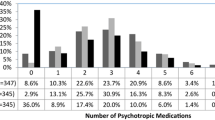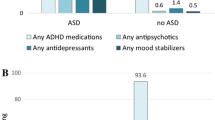Abstract
Medication use was examined in 286 adolescents and adults with ASD over a 4.5 year period. A total of 70% were taking a psychotropic or non-psychotropic medication at the beginning of the study. Both the number of psychotropic and non-psychotropic medications taken, and the proportion of individuals taking these medications, increased significantly over the study period, with 81% taking at least one medication 4.5 years later. Our findings suggested a high likelihood of staying medicated over time. Thus, adolescents and adults with ASD are a highly and increasingly medicated population.
Similar content being viewed by others
References
Aman, M. G. (1996). Stimulant drugs in the developmental disabilities revisited. Journal of Developmental and Physical Disabilities, 8, 347–365. doi:10.1007/BF02578400.
Aman, M. G., & Langworthy, K. S. (2000). Pharmacotherapy for hyperactivity in children with autism and other pervasive developmental disorders. Journal of Autism and Developmental Disorders, 30, 451–459. doi:10.1023/A:1005559725475.
Aman, M. G., & Madrid, A. (1999). Atypical antipsychotics in persons with developmental disabilities. Mental Retardation and Developmental Disabilities Research Reviews, 5, 253–263. doi:10.1002/(SICI)1098-2779(1999)5:4<253::AID-MRDD2>3.0.CO;2-R.
Aman, M. G., Van Bourgondien, M. E., Wolford, P. L., & Sarphare, G. (1995). Psychotropic and anticonvulsant drugs in subjects with autism: Prevalence and patterns of use. Journal of the American Academy of Child and Adolescent Psychiatry, 34, 1672–1681. doi:10.1097/00004583-199512000-00018.
Aman, M. G., Arnold, L. E., & Armstrong, S. C. (1999). Review of serotonergic agents and perseverative behavior in patients with developmental disabilities. Mental Retardation and Developmental Disabilities Research Reviews, 5, 279–289. doi:10.1002/(SICI)1098-2779(1999)5:4<279::AID-MRDD5>3.0.CO;2-6.
Aman, M. G., Lam, K. S. L., & Collier-Crespin, A. (2003). Prevalence and patterns of use of psychoactive medicines among individuals with autism in the autism society of Ohio. Journal of Autism and Developmental Disorders, 33, 527–534. doi:10.1023/A:1025883612879.
Aman, M. G., Lam, K. S. L., & Van Bourgondien, M. E. (2005). Medication patterns in patients with autism: Temporal, regional, and demographic influences. Journal of Child and Adolescent Psychopharmacology, 15, 116–126. doi:10.1089/cap.2005.15.116.
Aman, M., Farmer, C., Hollway, J., & Arnold, L. E. (2008). Treatment of inattention, overactivity, and impulsiveness in autism spectrum disorders. Child and Adolescent Psychiatric Clinics of North America, 17, 713–738. doi:10.1016/j.chc.2008.06.009.
American Psychiatric Association. (2000). Diagnostic and statistical manual of mental disorders (4th ed.). Washington, DC: American Psychiatric Association.
Brereton, A. V., Tonge, B. J., & Einfeld, S. L. (2006). Psychopathology in children and adolescents with autism compared to young people with intellectual disability. Journal of Autism and Developmental Disorders, 36, 863–870. doi:10.1007/s10803-006-0125-y.
Broadstock, M., Doughty, C., & Eggleston, M. (2007). Systematic review of the effectiveness of pharmacological treatments for adolescents and adults with autism spectrum disorder. Autism, 11, 335–348. doi:10.1177/1362361307078132.
Bryson, S. E., & Smith, I. M. (1998). Epidemiology of autism: Prevalence, associated characteristics, and implications for research and service delivery. Mental Retardation and Developmental Disabilities Research Reviews, 4, 97–103. doi:10.1002/(SICI)1098-2779(1998)4:2<97::AID-MRDD6>3.0.CO;2-U.
Canitano, R. (2007). Epilepsy in autism spectrum disorders. European Child and Adolescent Psychiatry, 16, 61–66. doi:10.1007/s00787-006-0563-2.
Cicchetti, D., & Rogosch, F. A. (2002). A developmental psychopathology perspective on adolescence. Journal of Consulting and Clinical Psychology, 70, 6–20. doi:10.1037/0022-006X.70.1.6.
Comer, R. J. (2002). PDR [physicians’ desk reference] drug guide for mental HEALTH professionals. Montvale, NJ: Thomson Medical Economics.
Fecteau, S., Mottron, L., Berthiaume, C., & Burack, J. A. (2003). Developmental changes of autistic symptoms. Autism, 7, 255–268. doi:10.1177/13623613030073003.
Fombonne, E. (2003). Epidemiological surveys of autism and other pervasive developmental disorders: An update. Journal of Autism and Developmental Disorders, 33, 365–382. doi:10.1023/A:1025054610557.
Greenberg, J. S., Seltzer, M. M., Hong, J., & Orsmond, G. I. (2006). Bidirectional effects of expressed emotion and behavior problems and symptoms in adolescents and adults with autism. American Journal of Mental Retardation, 111, 229–249. doi:10.1352/0895-8017(2006)111[229:BEOEEA]2.0.CO;2.
Hanson, E., Kalish, L. A., Bunce, E., Curtis, C., McDaniel, S., Ware, J., et al. (2007). Use of complementary and alternative medicine among children diagnosed with autism spectrum disorder. Journal of Autism and Developmental Disorders, 37, 628–636. doi:10.1007/s10803-006-0192-0.
Keck, P. E. (2005). Bipolar depression: A new role for atypical antipsychotics? Bipolar Disorders, 7, 34–40. doi:10.1111/j.1399-5618.2005.00213.x.
King, B. H., Hollander, E., Sikich, L., McCracken, J. T., Scahill, L., Bregman, J. D., Donnelly, C. L., Anagnostou, E., Dukes, K., Sullivan, L., Hirtz, D., Wagner, A., Ritz, L., & STAART Psychopharmacology Network. (2009). Lack of efficacy of citalopram in children with autism spectrum disorders and high levels of repetitive behavior. Archives of General Psychiatry (in press).
Langworthy-Lam, K. S., Aman, M. G., & Van Bourgondien, M. E. (2002). Prevalence and patterns of use of psychoactive medicines in individuals with autism in the Autism Society of North Carolina. Journal of Child and Adolescent Psychopharmacology, 12, 311–321. doi:10.1089/104454602762599853.
Lounds, J., Seltzer, M. M., Greenberg, J. S., & Shattuck, P. (2007). Transition and change in adolescents and young adults with autism: Longitudinal effects on maternal well-being. American Journal of Mental Retardation, 112, 401–417. doi:10.1352/0895-8017(2007)112[401:TACIAA]2.0.CO;2.
Martin, A., Scahill, L., Klin, A., & Volkmar, F. R. (1999). Higher-functioning pervasive developmental disorders: Rates and patterns of psychotropic drug use. Journal of the American Academy of Child and Adolescent Psychiatry, 38, 923–931. doi:10.1097/00004583-199907000-00024.
Matson, J. L., & Dempsey, T. (2008). Autism spectrum disorders: Pharmacotherapy for challenging behaviors. Journal of Developmental and Physical Disabilities, 20, 175–191. doi:10.1007/s10882-007-9088-y.
Mawhood, L., Howlin, P., & Rutter, M. (2000). Autism and developmental receptive language disorder: A comparative follow-up in early adult life. I. Cognitive and language outcomes. Journal of Child Psychology and Psychiatry, and Allied Disciplines, 41, 547–559. doi:10.1111/1469-7610.00642.
McDougle, C. J., Scahill, L., McCracken, J. T., Aman, M. G., Tierney, E., Arnold, L. E., et al. (2000). Research Units on Pediatric Psychopharmacology (RUPP) Autism Network. Background and rationale for an initial controlled study of risperidone. Child and Adolescent Psychiatric Clinics of North America, 9, 201–224.
Myers, S. M. (2007). The status of pharmacotherapy for autism spectrum disorders. Expert Opinion on Pharmacotherapy, 8, 1579–1603. doi:10.1517/14656566.8.11.1579.
Posey, D. J., Erickson, C. A., Stigler, K. A., & McDougle, C. J. (2006). Use of selective reuptake inhibitors in autism and related disorders. Journal of Child and Adolescent Psychopharmacology, 16, 181–186. doi:10.1089/cap.2006.16.181.
Posey, D., Stigler, K., Erickson, C., & McDougle, C. (2008). Antipsychotics in the treatment of autism. The Journal of Clinical Investigation, 118, 6–14. doi:10.1172/JCI32483.
Research Units on Pediatric Psychopharmacology (RUPP) Autism Network. (2002). Risperidone in children with autism and serious behavioral problems. The New England Journal of Medicine, 347, 314–321. doi:10.1056/NEJMoa013171.
Research Units on Pediatric Psychopharmacology (RUPP) Autism Network. (2005). Risperidone treatment of autistic disorder: Longer term benefits and blinded discontinuation after six months. The American Journal of Psychiatry, 162, 1361–1369. doi:10.1176/appi.ajp.162.7.1361.
Scahill, L., Koenig, K., Carroll, D. H., & Pachler, M. (2007). Risperidone approved for the treatment of serious behavioral problems in children with autism. Psychopharmacology, 20, 188–190.
Seltzer, M. M., Krauss, M. W., Shattuck, P. T., Orsmond, G., Swe, A., & Lord, C. (2003). The symptoms of autism spectrum disorders in adolescence and adulthood. Journal of Autism and Developmental Disorders, 33, 565–581. doi:10.1023/B:JADD.0000005995.02453.0b.
Shattuck, P. T., Seltzer, M. M., Greenberg, J. S., Orsmond, G. I., Bolt, D., Kring, S., et al. (2007). Change in autism symptoms and maladaptive behaviors in adolescents and adults with an autism spectrum disorder. Journal of Autism and Developmental Disorders, 37, 1735–1747. doi:10.1007/s10803-006-0307-7.
Tsakanikos, E., Costello, H., Holt, G., Sturmey, P., & Bouras, N. (2007). Behavior management problems as predictors of psychotropic medication and use of psychiatric services in adults with autism. Journal of Autism and Developmental Disorders, 37, 1080–1085. doi:10.1007/s10803-006-0248-1.
Witwer, A., & Lecavalier, L. (2005). Treatment incidence and patterns in children and adolescents with autism spectrum disorders. Journal of Child and Adolescent Psychopharmacology, 15, 671–681. doi:10.1089/cap.2005.15.671.
Acknowledgments
This manuscript was prepared with support from the National Institute on Aging (R01 AG08768), the National Institute on Child Health and Human Development (P30 HD03352), and the Autism Society of Southeastern Wisconsin.
Author information
Authors and Affiliations
Corresponding author
Rights and permissions
About this article
Cite this article
Esbensen, A.J., Greenberg, J.S., Seltzer, M.M. et al. A Longitudinal Investigation of Psychotropic and Non-Psychotropic Medication Use Among Adolescents and Adults with Autism Spectrum Disorders. J Autism Dev Disord 39, 1339–1349 (2009). https://doi.org/10.1007/s10803-009-0750-3
Received:
Accepted:
Published:
Issue Date:
DOI: https://doi.org/10.1007/s10803-009-0750-3




